Smiley's Workshop — AVR C Programming Workshop Series - Part 14
Last episode, we learned how to build a command interpreter and how to make beautiful music (okay, noise) on a piezo element, using parts from the Arduino Projects Kit. This time, we're going to look at components from the kit that sense light and temperature.
Recap
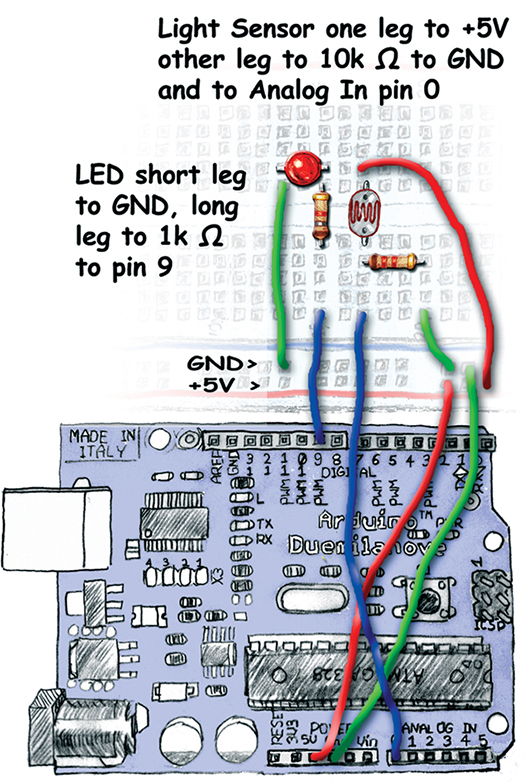 |
FIGURE 1. CdS light sensor layout.
|
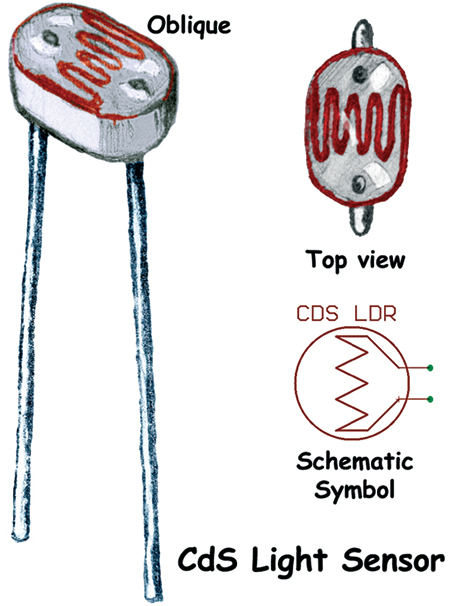 |
FIGURE 2. CdS light sensor.
|
In recent Workshops, we've been using a new development board and components kit: the Arduino Duemilanove and the Arduino Projects Kit (see below). We recognized that The Arduino Way (TAW) is a very simple and easy way to begin using microcontrollers. And we learned, that while TAW uses a C-like language, it does not (IMHO) provide a clear path to learning the C or AVR architecture — both of which are our long-term goals for this Workshop series. So, we were introduced to A C Way (ACW) that uses more standard (again IMHO) AVR tools. We decided to discuss projects using the kit in TAW, but also provided the software ACW in the Workshop zip file for those ready to move on. After we've introduced all the kit parts, we will then move exclusively to ACW since we will be looking at issues that are more difficult to accomplish TAW (such as using timer interrupts).
Light Sensor
Cadmium Sulfide (CdS) has the interesting property that its resistance drops proportional to the amount of light falling on it. Figure 2 shows the sensor in the Arduino Projects Kit. I'm not going to try to explain how this works since Einstein got a Nobel Prize for explaining it and apparently even he wasn't completely correct. In the dark, the resistance is about 138K ohms that drops to about 23K ohms under my work lights. What you get will, of course, vary depending on your lights. Theoretically, you could use this to make a sensor that outputs some physical measure of light such as lumens, but the process of calibrating such a sensor to a standard brightness is far more complex than we want to get into at the moment. So, we will simply use our sensor to recognize changes in light in our specific environment and use those changes to modify the blink rate of an LED as an indicator of relative brightness.
The source for this code is nearly identical to the AnalogInput example in the Arduino IDE and the code ported from TAW to ACW in Workshop 12 (you can get that code from the workshop12.zip file available at www.nutsvolts.com, in the downloads for that article). Try not to get confused between the AnalogInput example and the code used for the layout in Figure 1. In the code, the ledPin should be changed to pin 9 and the sensor pin to Analog In 0. And no, I didn't move these pins around to confuse you. I did it to confuse myself. (Sorry about that.) It does show how easy it is to change the pins in either the code or the layouts just as long as you keep them consistent.
Light Sensor Components, Schematic, Layout
You can follow the schematic in Figure 3 and the layout in Figure 1 to build this light sensor project hardware. Then, modify the Arduino example for Analog Input to conform to the actual pinout.
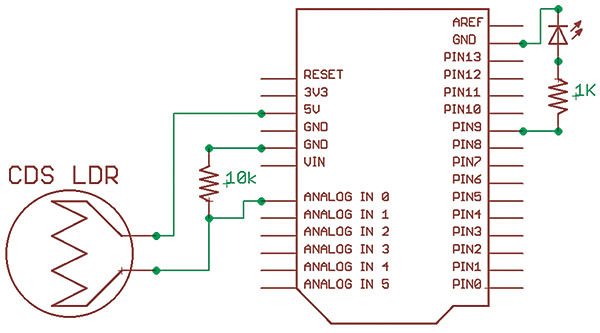 |
| FIGURE 3. CdS light sensor schematic. |
A Word or Two about Storing and Showing Sensor Data
We used the cop-out with the light sensor that calibrating the data to some physical reference was beyond what we want to do here (and 'we' didn't even ask for your opinion!), so we let an LED blink at a rate proportional to the sensor output from the lights in my personal workshop. We can assume that your workshop will be more or less lighted the same and that you can adjust the code if you live in a cave or on a beach. But what if we wanted to calibrate the sensor to some actual physical measure of light that contains — as real physics often does — some fractional data?
There are many situations where we don't really care if anybody ever sees any indication of a sensor output (like the O2 sensor in our car) since the value is being used inside an embedded system that percolates along without our help. Sometimes — such as when we are sensing room temperature — we want the sensor output to have some meaning to us.
Our next project uses the LM35 temperature sensor from the Arduino Projects Kit and outputs 10 mV per degree Centigrade accurate to 0.5 °C, and while that is a fun fact, we'd hardly know that the room was too darn hot based on a reading of 0.375 volts (never mind our flop-sweat as a trust-worthy sensor). We want to see that it is 99.5°F [37.5 °C for the rest of the world who can translate the output mV to °C in their head if they wanted to, but I think Fahrenheit, so 99.5 is hot and 37.5 is cold]. Anyway, the point is that we want to see something meaningful to us.
A Quick Introduction to Signed Decimal Numbers
This brings us to an issue with computers. Computers use integers (whole numbers {0,1,2,3,…}) to manipulate data, but we want to see temperatures with decimal fractions; 98 won't cut it, but 98.6 is a good healthy number. Also, the LM35 is accurate to 0.5°C so why waste good fractional information? In our specific case, we use an ADC to measure a value expressed as a whole number between 0 and 1023, but we will be showing a temperature such as 98.6°F, with an integer part (98), a decimal point (.), and a decimal part (6). To further complicate things, our temperature scales also use negative numbers (like the temperature at which nitrogen liquefies: -346°F).
Computers store data as whole numbers and they either have special hardware or software to manipulate this basic whole number data type as other data types (such as negative or decimal numbers). They pretend to work with decimal numbers by storing the integer part and the decimal part as separate whole numbers. They can be told to consider a number as signed (can hold positive + and negative -) by looking at the most significant bit of the data. [A byte holds 0 to 255, a signed byte 'holds' -128 to +127 where the highest bit represents the sign.] All this is by way of introduction, since going into the details can get complex quick. We will look at a technique for keeping our data in the original ADC-generated whole numbers (10-bits or 0 to 1023) while presenting that data to people in a human comprehensible format such as a signed decimal number.
Showing Integer Data As Signed Decimal Fractions
Our focus in this article is TAW, but to help with some concepts, we need to spend a few moments ACW. The C programming language has a lot of tools that help the user convert between data types. We could load our ADC data into double or floating-point data types; do the math that converts the ADC reading to 'myTemp = 98.6;' and then print it with: printf("Temperature = %f",myTemp). We could, that is, if we want to drag along a couple of extra kilobytes of code to process floating-point data. That is a lot of code space (expensive in microcontrollers) for a little convenience, so the avr-libc uses several versions of 'printf' that compile to less functional but much smaller versions for folks who aren't interested in the extra data conversion features. The avr-libc default version when you use printf("Temperature = %f",myTemp) will output: "Temperature = ?" since it — by default — doesn't do floating-point. This causes no end of confusion to novices who learn C from K&R but then don't read the avr-libc manual. [Too frequent AVRFreaks question: "Plz hlp me!!!!!!! I gt a '?' whn I uz printf, why zat?" Too frequent answer: "RTFM and learn to type!"] You can read all about this in the avr-libc manual, but I recommend just forgetting about using and printing real floating-point data for the time being and use the method we'll discuss in this section which works equally well for TAW and ACW.
Let’s say we want to print the normal human body temperature in Fahrenheit, which requires a decimal fraction: 98.6°F. The first trick we use is to keep our body temperature data stored in integers that are ten times the real value. We thus store 986 rather than 98.6. The second trick is to recover the real value for the integer and decimal fraction parts only when we want to show the data to people. The final trick is to print these two values separately with a decimal point printed between them. We show the text 98.6 by separately printing the '98' then a decimal point '.', and then the fractional part '6'. We will use the C '/' division and '%' modulo operators to get the integer and fractional parts of the number.
The '/' division operator in C yields only the integer part of the division so in C, 986/10 = 98. The '%' modulo operator yields only the remainder part of a division so in C, 986 = 6. We can use these operators as follows:
// show 986 as 98.6<br />
whole = 986/10; // divide to get the integer<br />
decimal = 986; // modulo to get the fraction<br />
printf("986/10 = %d.%d", whole,decimal);
And the results output to the terminal would be:
986/10 = 98.6
This technique will also come in handy with TAW since the Serial.println() function throws away the fractional part of a floating-point value so you will have to determine both the whole and decimal parts, and print them with two separate calls to the Serial.Print function as we will see in a minute.
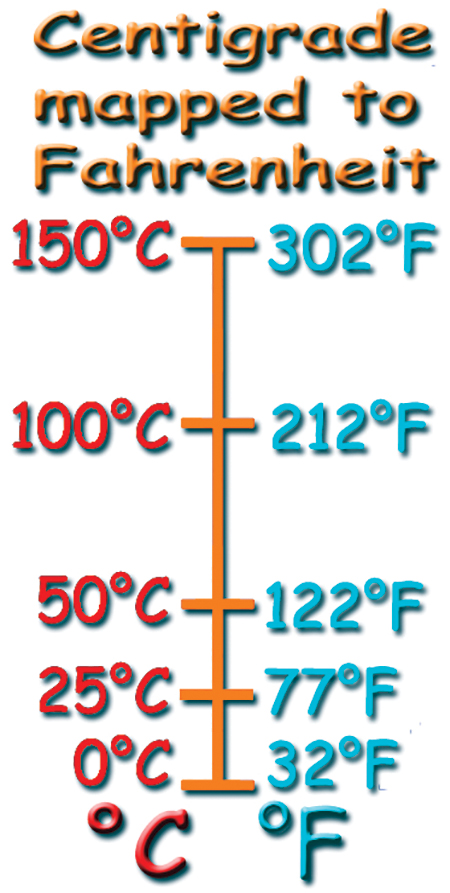 |
| FIGURE 4. Centigrade mapped to Fahrenheit. |
Converting Centigrade to Fahrenheit
Let’s take a moment to look at another issue related to presenting the data specific to temperature. We are storing raw integers from the ADC that map directly to Centigrade values (we'll look at the electrical and microcontroller details in a minute). And, while I have nothing against °C, I am at the moment sweating to °F, as are many of the readers of this Workshop. We can use the standard conversion formula:
Fahrenheit = ((9*Centigrade)/5) + 32
This formula maps the data as shown in Figure 4. Be sure and look at the showTemp() function shown in the 'LM35_Temperature Source Code' below since I also round off the data to 0.5 to conform to the sensor accuracy.
LM35_Temperature Source Code
The full source code in TAW and ACW for this project is available in the Workshop14.zip.
// LM35_Temperature TAW<br />
// Joe Pardue June 4, 2009
// variable to hold the analog input value<br />
int analogValue = 0;<br />
<br />
// variables used to fake the decimal value<br />
int whole = 0;<br />
int decimal = 0;
// For the Arduino using 5V, the ADC measures<br />
// 4.9 mV per unit use 49 to avoid floats<br />
#define ADCUnit 49
void showTemp(int ADCin);
void setup()<br />
{<br />
// begin the serial communication<br />
Serial.begin(9600);<br />
}
void loop()<br />
{<br />
// read the voltage on Analog Pin 0<br />
analogValue = analogRead(0);<br />
<br />
// show the reading with faked decimals<br />
showTemp(analogValue);<br />
<br />
// delay 1 second before the next reading:<br />
delay(1000);<br />
}
void showTemp(int ADCValue)<br />
{<br />
// print ADC value<br />
Serial.print("1.06 TAW LM35 - raw ADC: ");<br />
Serial.print(ADCValue, DEC);<br />
<br />
// make Centigrade<br />
whole = (ADCValue * ADCUnit)/100;<br />
decimal = (ADCValue * ADCUnit)0;<br />
<br />
// round to '0.5'
if(decimal > 50){ decimal = 0; whole +=1;}<br />
else decimal = 5;<br />
<br />
// print degrees Centigrade<br />
Serial.print(" > degree C: ");<br />
Serial.print(whole, DEC);<br />
Serial.print('.');<br />
Serial.print(decimal, DEC);<br />
<br />
// convert Centigrade to Fahrenheit<br />
whole = ((9*(ADCValue * ADCUnit))/5)/100;<br />
decimal = ((9*(ADCValue * ADCUnit))/5)0;
// round to '0.5'<br />
if(decimal > 50){ decimal = 0; whole +=1;}<br />
else decimal = 5;<br />
<br />
// print in degrees Fahrenheit<br />
Serial.print(" > degree F: ");<br />
whole += 32; // scale it to °F<br />
Serial.print(whole, DEC);<br />
Serial.print('.');<br />
Serial.println(decimal, DEC);<br />
}
The output of this code in the Arduino IDE serial monitor is shown in Figure 5.
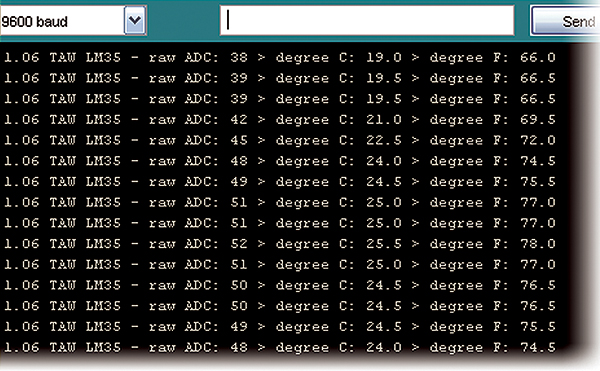 |
| FIGURE 5. Output in Arduino Serial Monitor. |
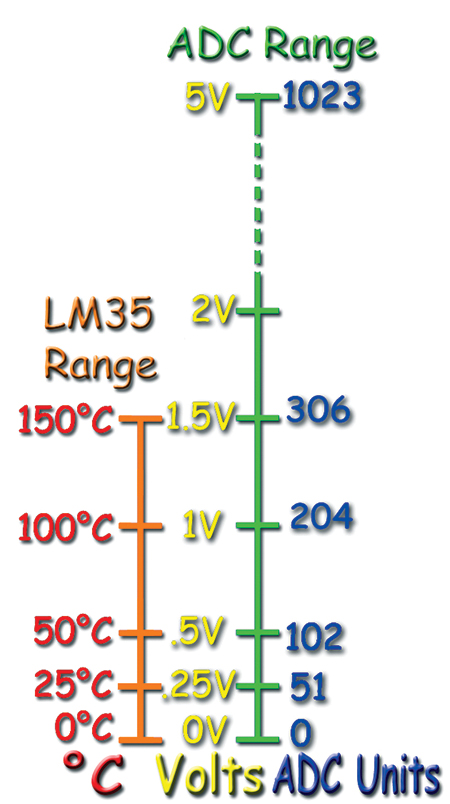 |
| FIGURE 6. Temperature, voltage, and ADC ranges. |
The LM35 Temperature Sensor
Now that we've looked at some ideas about how to present integer data with a faked decimal point, let’s look at how to get that data.
The LM35 temperature sensor outputs voltage that is linearly proportional to the temperature in degrees Celsius (Centigrade). The LM35 datasheet says: "0.5°C accuracy guaranteeable at 25°C" and since it outputs 10 mV per °C (5 mV per 0.5°C), if we can measure the voltage with an accuracy of 5 mV we will match the LM35 accuracy.
Our 10-bit ADC will map an input voltage from zero to five volts to integers from 0 to 1023. The resolution is 5V/1024 ADCunits = .0049V/ADCunit (.0049V is 4.9 mV). The LM35 accurately outputs 5 mV per °C and the ADC measures 4.9 mV per ADCunit, so our AVR ADC is well matched with the LM35 for accuracy.
As we've discussed above, we don't want to mess with decimal fractions. So, first we note that 4.9 mV is .0049 volts so we will multiply our per ADC unit by 10,000, giving us the whole number 49 for each ADC unit. This is the value we will store [thus the ADCUnit used in the source code]. For example, if the ADC reads 204 (out of a maximum of 1023), we multiple 49*204 = 9996, which is the integer that we store. We will only extract the decimal temperature when we want to show it. In this case, the actual temperature is 100°C or 212°F as shown in Figure 6.
Temperature Sensor Components, Schematic, Layout
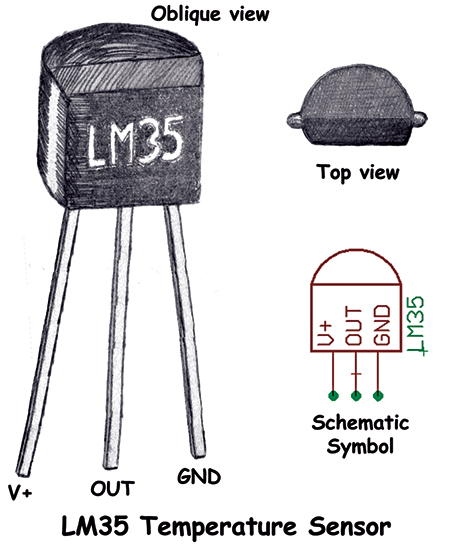 |
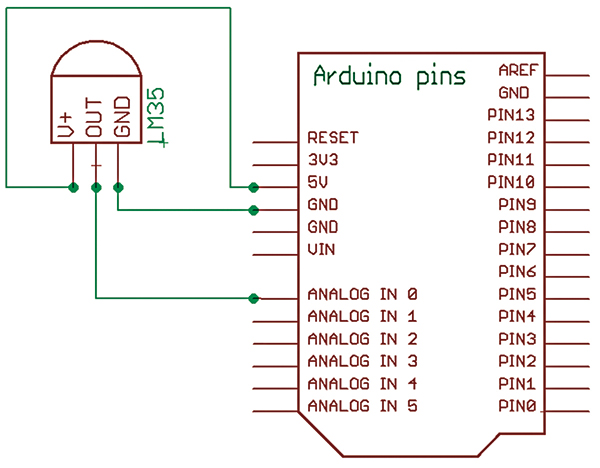 |
| FIGURE 7. LM35 temperature sensor. |
FIGURE 8. Temperature sensor schematic. |
The hardware construction is fairly simple for this project. Figure 7 shows the device we will be using. Figure 8 shows how we will hook it up using just three wires for +5V, GND, and Analog Pin 0 as shown in Figure 9.
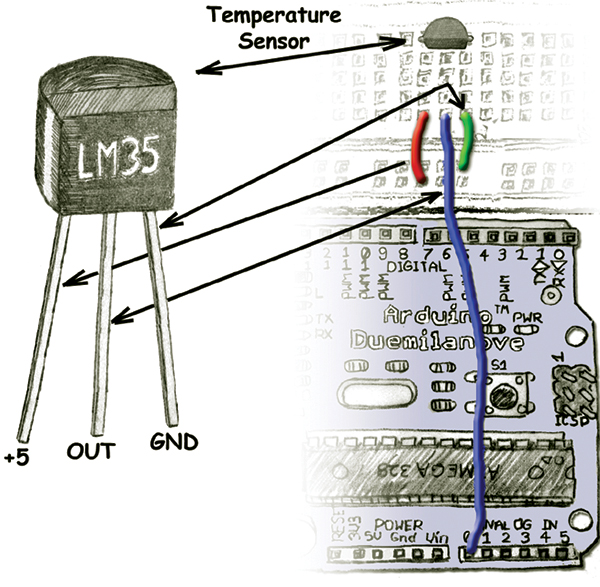 |
| FIGURE 9. Temperature sensor layout drawing. |
Once you get this working, you can do a quick experiment to demonstrate the lag in the measured temperature and the external temperature. It takes a few seconds for the external temperature to move from the surface of the LM35 to the sensor. You can see this by observing the room temperature output, then lightly squeezing the LM35 between your thumb and index finger. As shown in Figure 5, it takes a couple of seconds to begin to respond; once you remove your fingers, it takes several seconds — depending on how long you held it — for it to get back to room temperature. In my case, it took a minute or so to go from the frigid 66.0°F (in the local bookstore where I tested it over a cup of too expensive tea) to a maximum of 85.0°F. I don't think this low temperature indicates anything about my zombihood, since the 98.6°F would require sticking the LM35 into a convenient orifice — something I'm not willing to do in public. (The lady at the next table was giving me strange looks, possibly because of my laptop/ALP setup and possibly because I was laughing out loud).
Okay, too much fun for one month. Next month we'll look at infrared object detection using the QRD1114 from the Arduino Projects Kits part, and we'll learn what bunnies and snakes have to do with counting tomato soup cans. NV
You can find the source code and supplements for this article in Workshop14.zip in the downloads section of the Nuts & Volts website and Smiley Micros website.
The Arduino Projects Kit
The Arduino projects kit is a special hardware pack that will help you get hands on experience as you follow along with this series. It provides components for use with Workshops 9, 10, 11, and many future Workshops. Over time, we'll learn simple ways to use these components, and more importantly, use them to drill down into the deeper concepts of C programming, AVR microcontroller architecture, and embedded systems principles.
The Arduino Projects kit is offered through the Nuts & Volts webstore and Smiley Micros website.
Back to top
Downloads
Smileys Workshop 200909 (Workshop14.zip)









